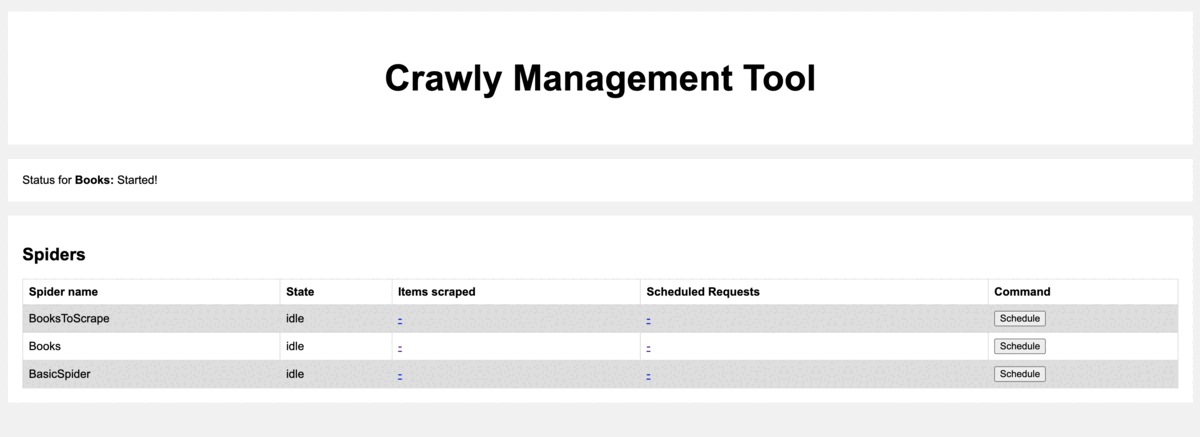Crawly is an application framework for crawling web sites and extracting structured data which can be used for a wide range of useful applications, like data mining, information processing or historical archival.
- Elixir
~> 1.14 - Works on GNU/Linux, Windows, macOS X, and BSD.
-
Create a new project:
mix new quickstart --sup -
Add Crawly as a dependencies:
# mix.exs defp deps do [ {:crawly, "~> 0.14.0"}, {:floki, "~> 0.33.0"} ] end
-
Fetch dependencies:
$ mix deps.get -
Create a spider
# lib/crawly_example/books_to_scrape.ex defmodule BooksToScrape do use Crawly.Spider @impl Crawly.Spider def base_url(), do: "https://books.toscrape.com/" @impl Crawly.Spider def init() do [start_urls: ["https://books.toscrape.com/"]] end @impl Crawly.Spider def parse_item(response) do # Parse response body to document {:ok, document} = Floki.parse_document(response.body) # Create item (for pages where items exists) items = document |> Floki.find(".product_pod") |> Enum.map(fn x -> %{ title: Floki.find(x, "h3 a") |> Floki.attribute("title") |> Floki.text(), price: Floki.find(x, ".product_price .price_color") |> Floki.text(), url: response.request_url } end) next_requests = document |> Floki.find(".next a") |> Floki.attribute("href") |> Enum.map(fn url -> Crawly.Utils.build_absolute_url(url, response.request.url) |> Crawly.Utils.request_from_url() end) %{items: items, requests: next_requests} end end
New in 0.15.0 (not released yet):
It's possible to use the command to speed up the spider creation, so you will have a generated file with all needed callbacks:
mix crawly.gen.spider --filepath ./lib/crawly_example/books_to_scrape.ex --spidername BooksToScrape -
Configure Crawly
By default, Crawly does not require any configuration. But obviously you will need a configuration for fine tuning the crawls: (in file:
config/config.exs)import Config config :crawly, closespider_timeout: 10, concurrent_requests_per_domain: 8, closespider_itemcount: 100, middlewares: [ Crawly.Middlewares.DomainFilter, Crawly.Middlewares.UniqueRequest, {Crawly.Middlewares.UserAgent, user_agents: ["Crawly Bot"]} ], pipelines: [ {Crawly.Pipelines.Validate, fields: [:url, :title, :price]}, {Crawly.Pipelines.DuplicatesFilter, item_id: :title}, Crawly.Pipelines.JSONEncoder, {Crawly.Pipelines.WriteToFile, extension: "jl", folder: "/tmp"} ]
New in 0.15.0 (not released yet):
You can generate example config with the help of the following command:
mix crawly.gen.config -
Start the Crawl:
iex -S mix run -e "Crawly.Engine.start_spider(BooksToScrape)" -
Results can be seen with:
$ cat /tmp/BooksToScrape_<timestamp>.jl
It's possible to run Crawly as a standalone application for the cases when you just need the data and don't want to install Elixir and all other dependencies.
Follow these steps in order to bootstrap it with the help of Docker:
-
Make a project folder on your filesystem:
mkdir standalone_quickstart -
Create a spider inside the folder created on the step 1. Ideally in a subfolder called spiders. For the example purposes we will re-use the: https://github.com/elixir-crawly/crawly/blob/8926f41df3ddb1a84099543293ec3345b01e2ba5/examples/quickstart/lib/quickstart/books_spider.ex
-
Create a configuration file (erlang configuration file format), for example:
[{crawly, [ {closespider_itemcount, 500}, {closespider_timeout, 20}, {concurrent_requests_per_domain, 2}, {middlewares, [ 'Elixir.Crawly.Middlewares.DomainFilter', 'Elixir.Crawly.Middlewares.UniqueRequest', 'Elixir.Crawly.Middlewares.RobotsTxt', {'Elixir.Crawly.Middlewares.UserAgent', [ {user_agents, [ <<"Mozilla/5.0 (Macintosh; Intel Mac OS X x.y; rv:42.0) Gecko/20100101 Firefox/42.0">>, <<"Mozilla/5.0 (X11; Linux x86_64) AppleWebKit/537.36 (KHTML, like Gecko) Chrome/51.0.2704.103 Safari/537.36">> ] }] } ] }, {pipelines, [ {'Elixir.Crawly.Pipelines.Validate', [{fields, [title, price, title, url]}]}, {'Elixir.Crawly.Pipelines.DuplicatesFilter', [{item_id, title}]}, 'Elixir.Crawly.Pipelines.Experimental.Preview', {'Elixir.Crawly.Pipelines.JSONEncoder'} ] }] }].** TODO - it would be nice to switch it to human readable format, e.g. YML
-
Now it's time to the Docker container:
bash docker run -e "SPIDERS_DIR=/app/spiders" -it -p 4001:4001 -v $(pwd)/spiders:/app/spiders -v $(pwd)/crawly.config:/app/config/crawly.config crawly:latest -
Now you can open the management interface and manage your spiders from there: localhost:4001. Management Interface
Please use discussions for all conversations related to the project
Crawly can be configured in the way that all fetched pages will be browser rendered, which can be very useful if you need to extract data from pages which has lots of asynchronous elements (for example parts loaded by AJAX).
You can read more here:
Crawly provides a simple management UI by default on the localhost:4001
It allows to:
- Start spiders
- Stop spiders
- Preview scheduled requests
- Preview items extracted so far (it's required to add the
Crawly.Pipelines.Experimental.Previewitem pipe to have items preview)
The CrawlyUI project is an add-on that aims to provide an interface for managing and rapidly developing spiders. Checkout the code from GitHub
To be discussed
- Blog post on Erlang Solutions website: https://www.erlang-solutions.com/blog/web-scraping-with-elixir.html
- Blog post about using Crawly inside a machine learning project with Tensorflow (Tensorflex): https://www.erlang-solutions.com/blog/how-to-build-a-machine-learning-project-in-elixir.html
- Web scraping with Crawly and Elixir. Browser rendering: https://medium.com/@oltarasenko/web-scraping-with-elixir-and-crawly-browser-rendering-afcaacf954e8
- Web scraping with Elixir and Crawly. Extracting data behind authentication: https://oltarasenko.medium.com/web-scraping-with-elixir-and-crawly-extracting-data-behind-authentication-a52584e9cf13
- What is web scraping, and why you might want to use it?
- Using Elixir and Crawly for price monitoring
- Building a Chrome-based fetcher for Crawly
- Blog crawler: https://github.com/oltarasenko/crawly-spider-example
- E-commerce websites: https://github.com/oltarasenko/products-advisor
- Car shops: https://github.com/oltarasenko/crawly-cars
- JavaScript based website (Splash example): https://github.com/oltarasenko/autosites
We would gladly accept your contributions!
Please find documentation on the HexDocs
Using Crawly on production? Please let us know about your case!
Copyright (c) 2019 Oleg Tarasenko
Licensed under the Apache License, Version 2.0 (the "License"); you may not use this file except in compliance with the License. You may obtain a copy of the License at http://www.apache.org/licenses/LICENSE-2.0
Unless required by applicable law or agreed to in writing, software distributed under the License is distributed on an "AS IS" BASIS, WITHOUT WARRANTIES OR CONDITIONS OF ANY KIND, either express or implied. See the License for the specific language governing permissions and limitations under the License.
- Update version in mix.exs
- Update version in quickstart (README.md, this file)
- Commit and create a new tag:
git commit && git tag 0.xx.0 && git push origin master --follow-tags - Build docs:
mix docs - Publish hex release:
mix hex.publish





